Procedimiento para la detección e identificación de esteroides anabólicos, ß2-agonistas, estimulantes y narcóticos
Abstract
Since the decade of the sixties, the competent international organizations
prohibited the use of certain stimulants of the Central Nervous System in the
competitions. Anabolic steroids were incorporated to the List of Prohibited Substances
in 1974 by the Medical Commission of the International Olympic Committee.
However, the detection and unequivocal identification of these compounds
was achieved in the decade of the eigthies, with the advance of technology and
incorporation of the Gas Chromatography coupled to Mass Spectrometry (GC-MS)
and the use of capillary columns. The present paper describes the simultaneous
determination of 76 compounds in urine (anabolic steroids, ß2-agonists, stimulants
and narcotics) by GC-MS. Quantitation of the endogenous steroids is presented,
which allows to establish the normal profiles of endogenous steroids and to determine
when there are deviations because of the use of synthetic steroids. Also, sample
preparation is presented that includes separation by solid phase extraction, enzymatic
hydrolysis, liquid-liquid extraction and the formation of trimethylsilyl derivatives.
Instrumental analysis was carried out using selecting ion monitoring
mode with relative retention time to the internal standard and the characteristic
ions of each compound as elements of primary identification. Reached detection
limits were between 2 and 10 ng/mL, requirement established by World Antidoping
Agency. Critical factors of the extraction procedure, enzymatic hydrolysis, evaluation
of analytical results and the internal quality control were described

Downloads
Published
How to Cite
Issue
Section
License

This work is licensed under a Creative Commons Attribution-NonCommercial-ShareAlike 4.0 International License.
Los autores que publican en esta revista están de acuerdo con los siguientes términos:
Los autores conservan los derechos de autor y garantizan a la revista el derecho de ser la primera publicación del trabajo al igual que licenciado bajo una Creative Commons Atribución-NoComercial-CompartirIgual 4.0 que permite a otros compartir el trabajo con un reconocimiento de la autoría del trabajo y la publicación inicial en esta revista.
Los autores pueden establecer por separado acuerdos adicionales para la distribución no exclusiva de la versión de la obra publicada en la revista (por ejemplo, situarlo en un repositorio institucional o publicarlo en un libro), con un reconocimiento de su publicación inicial en esta revista.
Se permite y se anima a los autores a difundir sus trabajos electrónicamente (por ejemplo, en repositorios institucionales o en su propio sitio web) antes y durante el proceso de envío, ya que puede dar lugar a intercambios productivos, así como a una citación más temprana y mayor de los trabajos publicados (Véase The Effect of Open Access) (en inglés).













